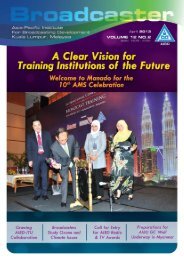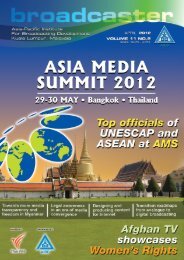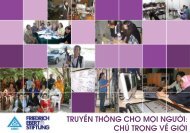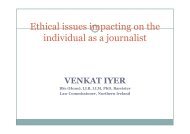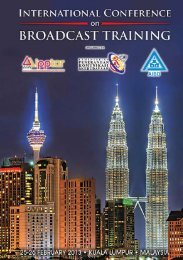SUMMIT
New Visions Asia Media Summit 2008 - AIBD
New Visions Asia Media Summit 2008 - AIBD
- No tags were found...
You also want an ePaper? Increase the reach of your titles
YUMPU automatically turns print PDFs into web optimized ePapers that Google loves.
Now, how do we bridge the gap? World leaders had pledged, as you know, at the World<br />
Summit on Informaon Society (WSIS) in Tunis in 2005 to acvate a plan that would bridge<br />
the digital divide between countries in Africa and Asia versus the rest of the developed<br />
world. While many countries have undeniably begun to make progress on their own<br />
towards closing the digital divide, few developing countries are in a posion to do so.<br />
Connect Africa Iniave, officially launched in Rwanda in 2007, brings together interna-<br />
onal bodies and the African Unions to help implement a number of the UN’s Interna-<br />
onal Communicaon Technology projects that aimed to impact on the development<br />
technology infrastructure in Africa. In doing so, partners build on the progress of countries<br />
which have established an ICT policy and regulatory environment to accommodate the<br />
private sector investment required for sustainable network build-out. These projects will<br />
in turn trigger a cycle of further investment and development.<br />
The World Bank sponsored a programme at the African Virtual University that has broadcasted<br />
over two thousand hours of instrucons to over nine thousand students in all<br />
regions of the sub-Sahara in Africa. The iniave has allowed the students to take courses<br />
given by professors from world-renowned educaonal instuons in Africa, North<br />
America and Europe.<br />
In June 2005, the UN’s Internaonal Telecommunicaons Union launched a project which<br />
favoured the whole globalisaon iniave. The iniave called, Connect the World, is a<br />
global mul-stakeholder effort established within the context of the WFIS to encourage<br />
partnerships to bridge the digital divide. The objecve is to bring access and internaonal<br />
telecommunicaons technology to people worldwide for whom making a simple<br />
telephone call remains out of reach. Keeping in mind that at present, ITU esmates that<br />
around eight hundred thousand villages or 30% of all villages worldwide are sll without<br />
any kind of connecon.<br />
In conclusion, WSIS in 2002 was touted as a “unique opportunity” to bridge the digital<br />
divide between the developed and the developing countries. Six years on, what and how<br />
much has changed? That queson lingers on. Through long and heated negoaons and<br />
thanks to the diplomac acvism of developing countries (mainly Ghana, South Africa,<br />
Botswana, Bangladesh, India and Senegal), stressing the need to combine private and<br />
public financing to bridge the digital divide, there appears to be a slight move towards<br />
efforts to improve the level of digital technology in developing countries.<br />
Experts say African countries need an addional infrastructure investment, exceeding 100<br />
billion US in the next five years alone to close the gap. Another key point emphasizes the<br />
importance of public policies, poinng to the need to integrate the development the<br />
development dimension in all naonal strategies addressing the informaon society. For<br />
the first me in history, the link between informaon and communicaon technology and<br />
poverty reducon is made by developing countries at a polical level.<br />
Phil Molefe, General Manager, Internaonal Affairs, South African Broadcasng Corporaon<br />
Limited (SABC), South Africa<br />
95



